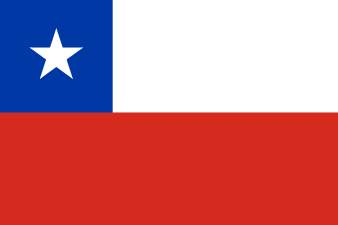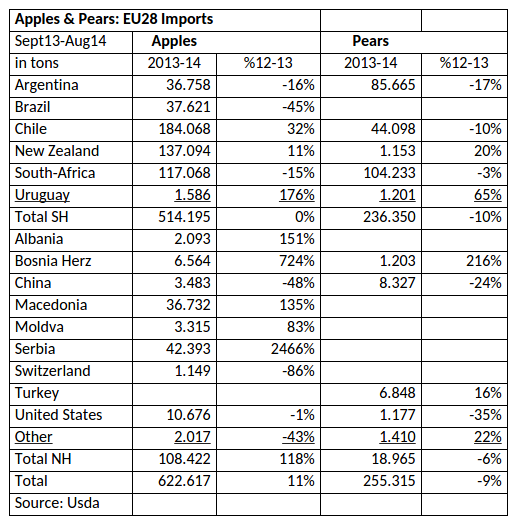
USDA FORECASTS 2014/15 MARKETING YEAR (in metric tons)
APPLES (marketing year July/June)
Production: up 11% rise to 2.38 million
Exports: down slightly (less than 0.5%) to 870,000
Imports: down slightly (just under 3%) to 41,000
PEARS (marketing year July/June)
Production: down 2.6% to 707,000
Exports: 146,000 (down slightly from 146,601)
Imports: 103,000 (up slightly from 102,209)
(World’s top pear producers: China, US, Italy)
TABLE GRAPES (marketing year June/May)
Production: down 20% to 960,000 on record of 1.2 million in 2013/2014
Exports: 470,300 (down from 500,971)
Imports: 22,320 (up from 20,237)
Withdrawal from market: 9,300
(World’s top table grape exporters: Chile, US, Italy)
The weather has favoured Italy’s 2014/15 apple marketing season but not that of its table grapes and pears, according to new forecasts by the USDA.
The country’s apple crop is expected to increase by 11% but, after a record harvest last season, that of table grapes will drop a fifth, mainly due to adverse conditions during flowering and fruit set.
And heavy rainfall during the fruit setting and maturity phases makes a 2.6% drop likely in the country’s pear supply compared to last season, the USDA said in its report “Italy: Fresh Deciduous Fruit Annual 2014”.
Apples: potential in North Africa, the Middle East
The fruit size for the apple season is expected to be above average and quality high.
“Remarkable increases” are forecast for Red Delicious (+19.6%), Granny Smith (+19.6%), Fuji (+12.1%), and Golden Delicious (+9.5%).
Last season, Italy’s apple exports to Russia (mostly Granny Smith and Golden) reached 26,318 tons but in light of the Russian ban since imposed, Italy’s apple sector could look to the growing markets of North Africa and Middle East, the USDA said.
Italy grows about a fifth of the EU-28’s apple production, with Trentino-South Tyrol – which delivers 70% of Italian apple production – alone supplying 15% of the European crop.
Pears: decline in acreage
With about 34,241ha, mainly in the northeast, Italy is the EU-28’s largest pear producer but the total of its pear orchard area has been declining in the last decade “due to lack of profitable investment opportunities,” the USDA said.
Emilia-Romagna is the area supplying two thirds of Italy’s total pear crop.
Abate Fetel is the dominant variety, followed by William B.C., Conference, Kaiser, Coscia-Ercollini, Decana, Max Red Bartlett, and Santa Maria. Production decreases are forecast for Kaiser, Decana del Comizio, Santa Maria, and William.
Table grapes: drop in wholesale prices
Aside from the unfavorable weather during flowering and fruit set, cold temperatures in mid-July damaged several plantations “thus affecting the fruit quality which overall is forecast to be good,” the USDA said.
“The production drop, slow consumption, and the Russian ban made wholesale prices drop by 25-30% compared to the last season from 1.30-1.50 €/kg to 0.70-1.20 €/kg.”
Italian table grape production – which ranks sixth globally in volume – is mainly in Apulia and Sicily, with Italia, Victoria, and Red Globe the varieties accounting for two thirds of the table grape area.
“In the last few years, Italy has gradually moved to seedless grapes cultivation, due to an increasing demand from intra and extra EU markets. Sugraone and Crimson are the most popular seedless varieties followed by Thompson, Centennial, and Sublime,” the USDA said.
Read the report: http://www.fas.usda.gov/data/italy-fresh-deciduous-fruit-annual-2014


